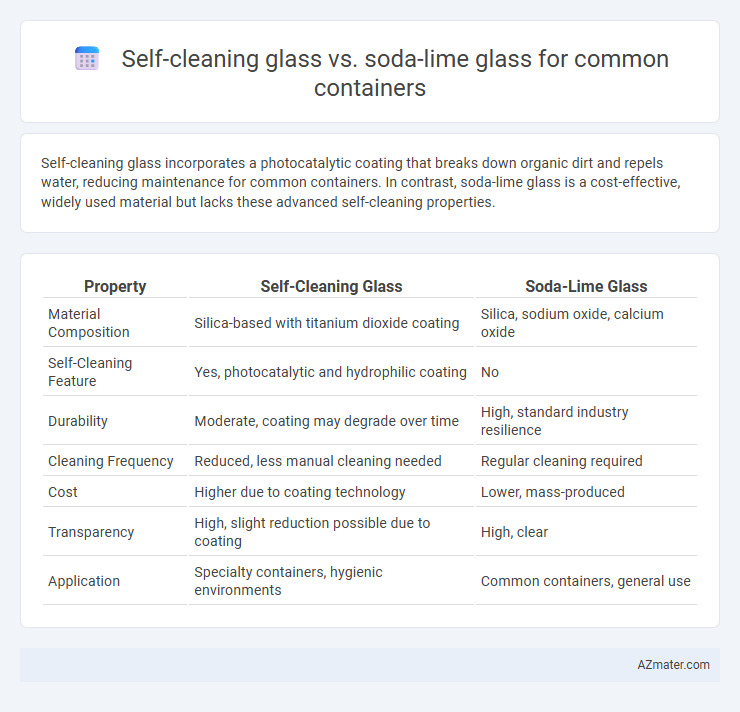Self-cleaning glass incorporates a photocatalytic coating that breaks down organic dirt and repels water, reducing maintenance for common containers. In contrast, soda-lime glass is a cost-effective, widely used material but lacks these advanced self-cleaning properties.
Table of Comparison
| Property | Self-Cleaning Glass | Soda-Lime Glass |
|---|---|---|
| Material Composition | Silica-based with titanium dioxide coating | Silica, sodium oxide, calcium oxide |
| Self-Cleaning Feature | Yes, photocatalytic and hydrophilic coating | No |
| Durability | Moderate, coating may degrade over time | High, standard industry resilience |
| Cleaning Frequency | Reduced, less manual cleaning needed | Regular cleaning required |
| Cost | Higher due to coating technology | Lower, mass-produced |
| Transparency | High, slight reduction possible due to coating | High, clear |
| Application | Specialty containers, hygienic environments | Common containers, general use |
Introduction to Self-Cleaning and Soda-Lime Glass
Self-cleaning glass incorporates a photocatalytic coating that breaks down organic dirt and uses rainwater to wash it away, reducing maintenance for container applications. Soda-lime glass, the most prevalent type of glass, is composed primarily of silica, soda, and lime, offering cost-effective durability and clarity for common containers. The innovative properties of self-cleaning glass provide enhanced cleanliness and reduced manual cleaning efforts compared to traditional soda-lime glass containers.
Composition and Manufacturing Process
Self-cleaning glass incorporates a titanium dioxide coating that breaks down organic matter through photocatalysis, a feature absent in standard soda-lime glass composed mainly of silica, soda, and lime. The manufacturing process for self-cleaning glass involves applying this nanostructured coating via methods like chemical vapor deposition or pyrolysis after the base glass is formed. Soda-lime glass is produced by melting raw materials at high temperatures followed by shaping processes such as blowing or pressing, making it simpler and more cost-effective for common container production.
Self-Cleaning Glass: How It Works
Self-cleaning glass contains a special titanium dioxide coating that activates under sunlight to break down organic dirt through a photocatalytic reaction. The surface then becomes highly hydrophilic, causing water to spread evenly and wash away loosened debris without leaving streaks. This technology significantly reduces the need for manual cleaning compared to traditional soda-lime glass used in common containers.
Soda-Lime Glass: Traditional Properties
Soda-lime glass, the most widely used material for common containers, offers excellent chemical durability, high transparency, and cost-efficiency, making it ideal for packaging beverages and food products. Its traditional properties include strong thermal resistance and ease of manufacturing, supporting recycling processes effectively. While self-cleaning glass provides advanced surface coatings for reduced maintenance, soda-lime glass remains a trusted choice due to its proven reliability and established production infrastructure.
Durability and Maintenance Comparison
Self-cleaning glass for common containers features a titanium dioxide coating that breaks down organic dirt, reducing maintenance frequency compared to soda-lime glass, which requires regular manual cleaning to avoid residue buildup. In terms of durability, soda-lime glass is generally more resistant to scratches and impact, while self-cleaning glass coatings may wear off over time, decreasing effectiveness and requiring reapplication. Choosing self-cleaning glass improves long-term cleanliness but may involve higher initial costs and potential maintenance of the coating's integrity.
Cost-effectiveness for Common Containers
Self-cleaning glass typically incurs higher initial costs compared to soda-lime glass due to its specialized coatings and manufacturing processes. Soda-lime glass remains the most cost-effective option for common containers, offering low production expenses and widespread availability. For budget-sensitive applications, soda-lime glass provides optimal affordability without compromising basic container functionality.
Environmental Impact and Sustainability
Self-cleaning glass significantly reduces water usage and chemical cleaning agents, enhancing environmental sustainability compared to conventional soda-lime glass used in common containers. Soda-lime glass, while recyclable, demands higher energy consumption during production and cleaning processes, contributing to greater carbon emissions. Incorporating self-cleaning coatings can extend the lifespan and reduce the ecological footprint of glass containers through lower maintenance and improved resource efficiency.
Practical Applications in Everyday Containers
Self-cleaning glass enhances everyday containers by reducing the need for frequent washing through its photocatalytic and hydrophilic coatings, making it ideal for water bottles and food jars where hygiene is crucial. Soda-lime glass, commonly used in containers, offers durability and cost-effectiveness but requires manual cleaning to prevent residue buildup and contamination. In practical applications, self-cleaning glass provides superior convenience and maintenance efficiency, while soda-lime glass remains favored for its accessibility and widespread availability.
Aesthetic and Functional Advantages
Self-cleaning glass offers superior aesthetic appeal by maintaining a clear, spotless surface through its hydrophilic and photocatalytic properties, reducing residue buildup compared to soda-lime glass. Functionally, self-cleaning glass minimizes maintenance needs and enhances visibility while soda-lime glass is more prone to staining and requires frequent cleaning. The durability and long-term clarity of self-cleaning glass provide a premium look and practicality for common containers.
Choosing the Right Glass Type for Your Needs
Self-cleaning glass offers enhanced convenience for common containers by reducing maintenance through its photocatalytic titanium dioxide coating that breaks down organic dirt. Soda-lime glass, being more affordable and widely used, provides durability and chemical resistance suitable for everyday storage without special surface treatments. Selecting the right glass depends on balancing budget constraints with the desire for low-maintenance features and specific use cases where cleanliness and ease of care are priorities.

Infographic: Self-cleaning glass vs Soda-lime glass for Common container
 azmater.com
azmater.com